Bead head nymphs
{{start}}
I am a firm believer that when fishing rivers you have to get down to where the fish are holding and also that flies particularly in faster running water should include “hot spots”. These flies satisfy both these requirements for me and consequently have a place in my Bead head fly box.
{{end}}
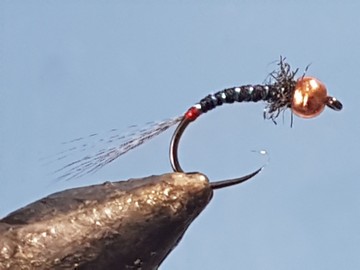
{{+1}}TBH Dross nymph variant{{-1}}
{{start}}
In 2018 I was introduced a fly called a Droz nymph that had skipped my attention even though it has been used for several seasons with great success in Tasmania, Victoria and even NSW. It's now one of the first river flies that I tie on.{{end}}

{{+1}}Perdigon (Spanish nymph) – gold micro glint{{-1}}
{{start}}
| A streamlined fast sinking fly that will anchor your team. |
Materials
| Hook | Head | Extra weight (optional) | Thread | Tail | Body | Thorax | Coating |
|---|---|---|---|---|---|---|---|
| Hanak 300BL #14 / #16 | 3.0mm / 2.5mm slotted faceted gold tungsten bead | 0.010 lead wire | Fl fire orange UTC UV thread | Coq de Leon Fibres | Brown Micro Glint | Black nail polish | UV Resin and then Varnish. |
Process
| A |
Adding extra weight to the fly.On this fly my preference is to keep the bead size down a little and to add extra weight to compensate for that. |

|
|---|
| B |
|

|
|---|
| C |
|
|
|---|
| D |
|

|
|---|
| E |
|

|
|---|
| F |
|

|
|---|
{{end}}
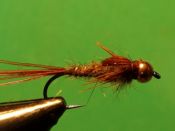
{{+1}}TBH “inch” nymph{{-1}}
{{start}}
This fly has it's origins based on my non bead-head inch nymph fly that I started tying over 20 years ago. For about 10 years now I have been tying this bead-head version in in black, dark olive, Adams colours, claret and brown. It's a great buggy looking fly and one of the on-going inclusions in my nymph fly box.{{end}}
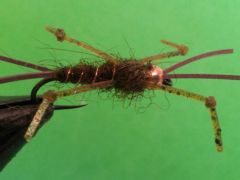
{{+1}}TBH stonefly{{-1}}
{{start}}
Stoneflies thrive in the rubble of cold well oxygenated rivers & streams. They are an available food source throughout the season and fish may feed on them to the exclusion of all other food sources particularly during hatches. The nymphs crawl along the bottom and exit the water at the stream or river edge where they hatch into stoneflies. To imitate this action the fly must be well weighted.{{end}}
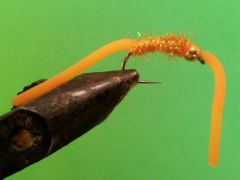
{{+1}}TBH squirmy worm{{-1}}
{{start}}
The material that this TBH Squirmy worm fly incorporates hit the market in 2014 with gusto. There are now plenty of versions of squirmy worm flies being tied and they have turned out to be a must have fly for use in both rivers and lakes. My version incorporates a process of tying the delicate squirmy wormie material in with a thread and dubbing rope than just thread making the fly much more durable.{{end}}
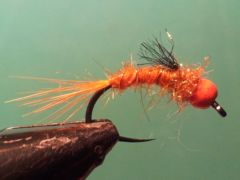
{{+1}}Carrot wet fly{{-1}}
{{start}}
This fly came about as an extension of the idea of using very popular carrot dry fly and has turned out to be a great weighted attractor fly to use on the top or middle dropper when fishing a representation fly on the point to river fish.{{end}}
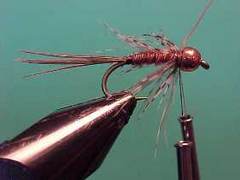
{{+1}}Hybrid spider nymph – Chatto’s original{{-1}}
{{start}}
This is more a class of flies rather than just one fly and is a hybrid of a spider fly and a bead head nymph with a tungsten bead up front. I carry 4 different hybrid spider nymphs in two sizes and find them particularly useful in situations where I need a bit of weight to get a fly down yet still want the anchor fly to fish well and be enticing to trout rather than just being an anchor for other flies in the team.{{end}}
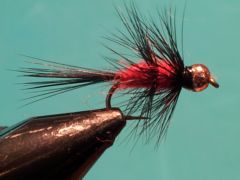
{{+1}}TBH fuzzy wuzzy{{-1}}
{{start}}
If you went back just a few years and you a asked an average fly fisher to name his for her favorite fly chances are it would be an unweighted, or lightly weighted probably with a few turns of lead wire, Fuzzy Wuzzy. The traditional Fuzzy Wuzzy has always been useful as a river and lake fly leading up to, through and just after the spawning season. This fly just extends the application of the standard Fuzzy Wuzzy an little further and the simple addition of the tungsten bead head makes it easier to get this fly down and bumping along the bottom where the fish are.{{end}}
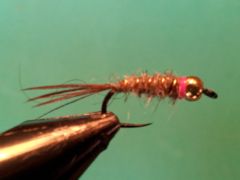
{{+1}}TBH collared hare and copper{{-1}}
{{start}}
A very effective fly yet perhaps the simplest of bead heads to tie. With elements of the hare and copper and an Adams fly in the dressing its logical that its default name became "hare and adams".{{end}}
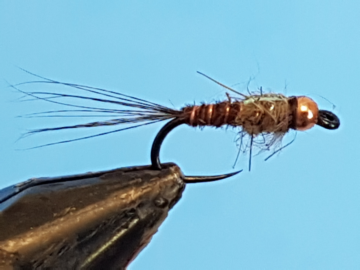
{{+1}}TBH flash back PTN{{-1}}
{{start}}
Jeremy Lucas was our river coach leading up to the 2012 World Fly Fishing Championships and was very keen on thinner flies for this early season competition. I think its a great interpretation of a classic fly and commend it for your consideration.{{end}}














